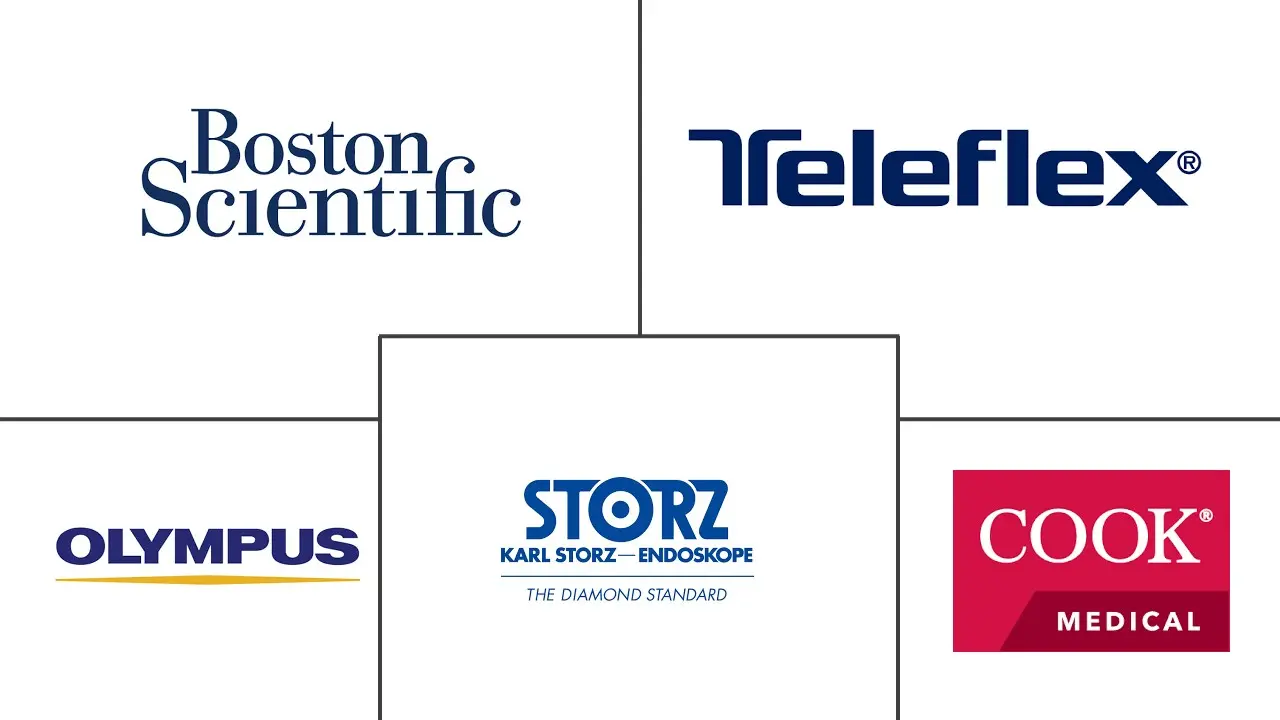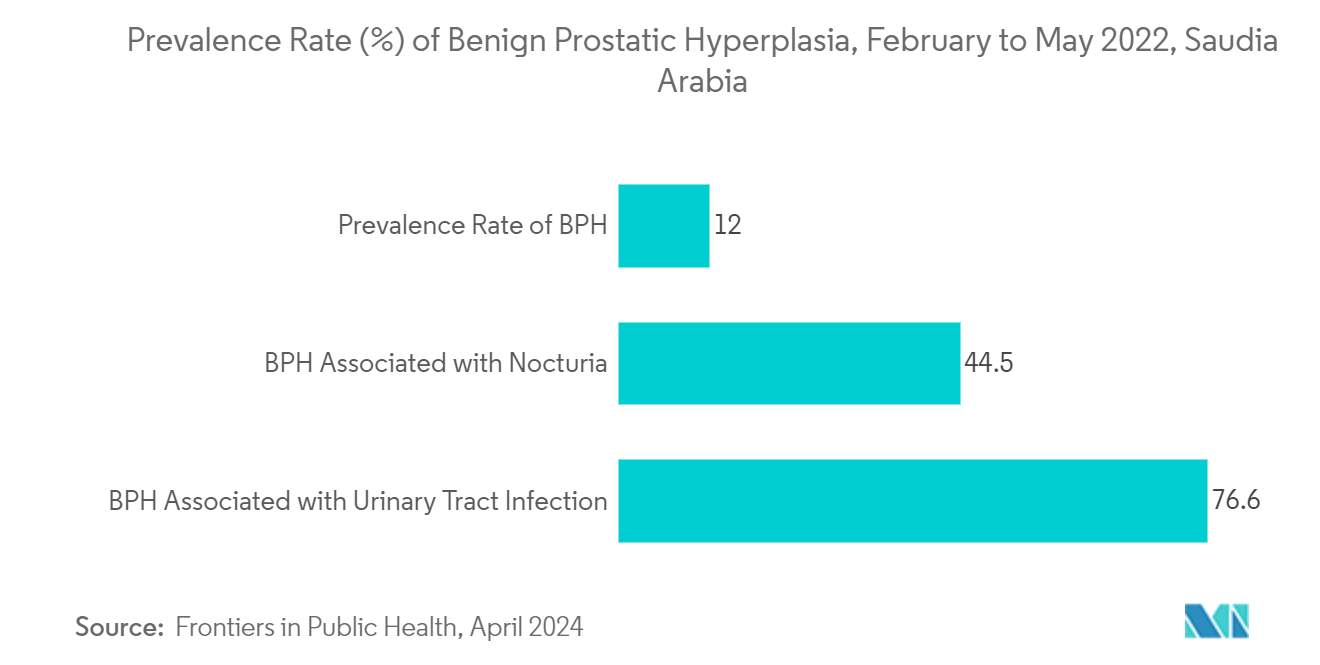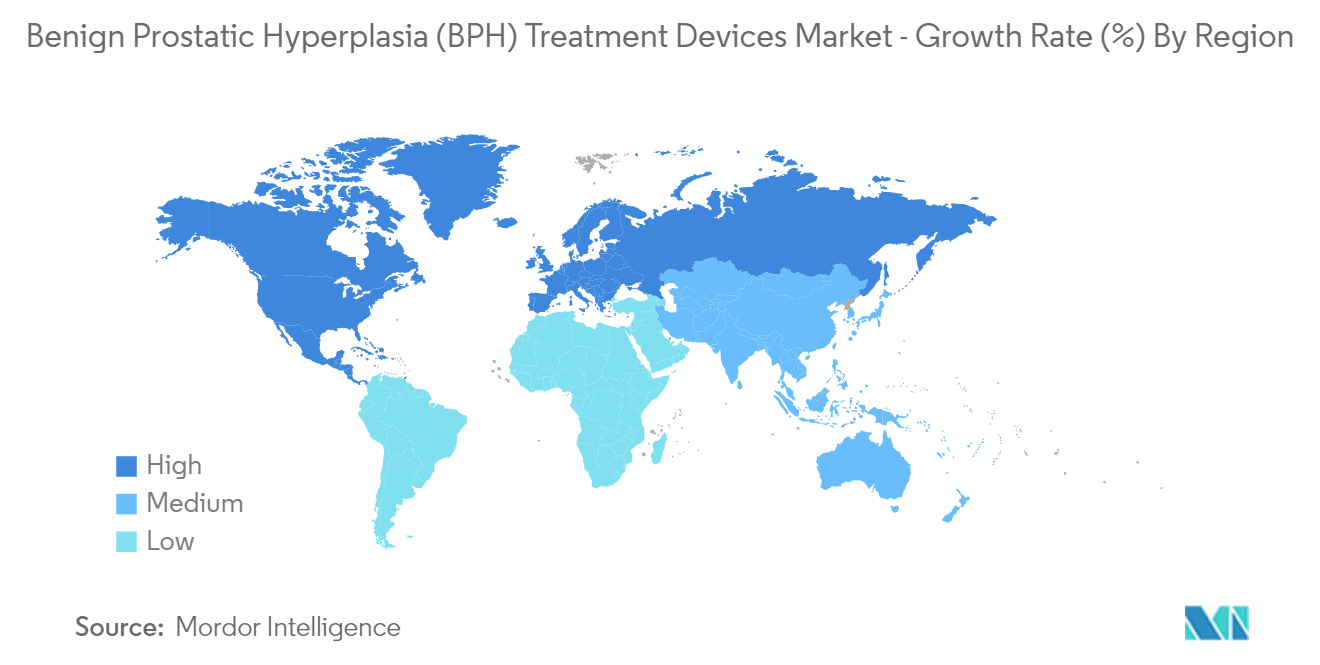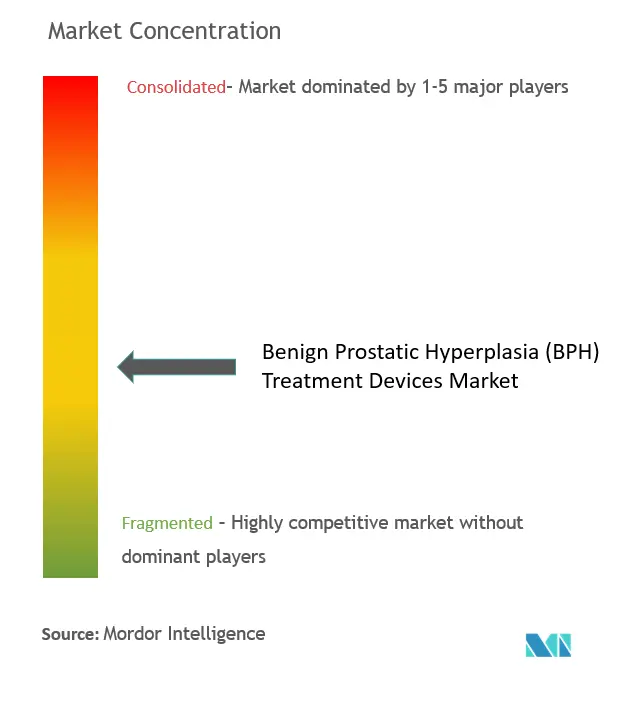Benign Prostatic Hyperplasia (BPH) Treatment Devices Market Size

| Study Period | 2021 - 2029 |
| Market Size (2024) | USD 1.64 Billion |
| Market Size (2029) | USD 2.32 Billion |
| CAGR (2024 - 2029) | 7.20 % |
| Fastest Growing Market | Asia Pacific |
| Largest Market | North America |
Major Players
*Disclaimer: Major Players sorted in no particular order |
Benign Prostatic Hyperplasia (BPH) Treatment Devices Market Analysis
The Benign Prostatic Hyperplasia Treatment Devices Market size is estimated at USD 1.64 billion in 2024, and is expected to reach USD 2.32 billion by 2029, growing at a CAGR of 7.20% during the forecast period (2024-2029).
Benign prostatic hyperplasia (BPH) is a non-cancerous enlargement of the prostate gland, commonly affecting men as they age. This condition can lead to urinary symptoms such as difficulty starting urination, weak urine flow, frequent urination, and the inability to empty the bladder completely. The BPH treatment devices market encompasses a range of medical devices designed to alleviate symptoms, reduce prostate size, and improve urinary function in patients with BPH. The BPH treatment devices market is experiencing significant growth due to the increasing prevalence of benign prostatic hyperplasia, technological advancements, and increased preference for minimally invasive treatments.
The rising prevalence of benign prostatic hyperplasia (BPH), particularly among men aged 40 and older, is a significant growth driver of the BPH treatment devices market. According to a study published in BMC Urology in November 2023, conducted in Homs, Syria, from January to March 2023, the prevalence of metabolic syndrome among BPH patients was 46.2%. The study revealed a strong association between metabolic syndrome and the severity of urinary symptoms as measured by the International Prostate Symptom Score (IPSS). Patients with metabolic syndrome exhibited higher IPSS scores, with 59.3% suffering from severe LUTS, compared to 36.2% of patients without metabolic syndrome.
Therefore, as the prevalence of BPH continues to rise, the demand for innovative and effective BPH treatment devices is expected to grow, driving market expansion.
Moreover, technological innovations, particularly in the field of robotics and minimally invasive procedures, have revolutionized the way BPH is treated, offering patients more precise, efficient, and less invasive options. For instance, a study published in Prostate International in June 2024 highlighted that a notable innovation in this area was the development of Aquablation, a robotic endoscopic platform specifically designed for BPH surgery. Aquablation uses a heat-free cavitating waterjet under real-time transrectal ultrasound guidance to execute resection plans that the surgeon pre-registers. This innovative approach is transformative, as it is effective for treating both small and large prostates, making it a versatile and valuable tool in BPH management. Thus, the rising adoption of such advanced technologies is enhancing patient outcomes and driving market growth.
The launch of advanced treatment devices in emerging markets underscores the increasing recognition of the benefits of minimally invasive procedures in managing BPH. For instance, in January 2023, Teleflex Incorporated commercially launched the UroLift System in India. This is a minimally invasive device designed to treat BPH, providing rapid symptom relief and enabling quick recovery. The introduction of the UroLift System in India marked a significant step forward in making advanced BPH treatment more accessible to patients in the region, reflecting the growing global demand for minimally invasive solutions. This is expected to drive the demand for benign prostatic hyperplasia (BPH) treatment devices over the next five years.
However, the high cost of advanced devices and lack of awareness and skilled professionals are expected to restrain market growth.
Benign Prostatic Hyperplasia (BPH) Treatment Devices Market Trends
The Laser-based Devices Segment is Expected to Witness Significant Growth Over the Forecast Period
Laser-based devices refer to medical technologies that use laser energy treatments that are less invasive than traditional surgical methods like transurethral resection of the prostate (TURP). These devices are designed to precisely remove or vaporize excess prostate tissue that is causing urinary obstruction and related symptoms, such as difficulty urinating, frequent urination, and weak urine flow.
The laser-based devices segment is gaining momentum due to the effectiveness and safety of the devices in treating lower urinary tract symptoms (LUTS) associated with BPH. For instance, according to a study published in the Journal of Urology in January 2024, photoselective vaporization of the prostate (PVP) utilizing laser technology was a preferred treatment option, especially for patients with specific medical considerations. The use of 120 W or 180 W laser platforms is effective; studies have demonstrated that these platforms offer comparable efficacy to other treatments, such as transurethral resection of the prostate (TURP) and holmium laser enucleation of the prostate (HoLEP) in prostates ranging from 80 to 150 g.
Therefore, the segment is experiencing growth due to the combination of efficacy, safety, and suitability of the devices for medically complicated patients.
The advanced laser system is designed to offer precise, minimally invasive treatment for BPH, making it a preferred choice for both patients and healthcare providers. For instance, in April 2023, Olympus Corporations' SOLTIVE SuperPulsed Thulium Fiber Laser, known for its efficacy in vaporizing prostate tissue with minimal thermal damage, represented a significant advancement in BPH care and was presented during the American Urology Association (AUA) annual meeting in Chicago.
Hence, there is an increasing demand for highly effective and minimally invasive alternatives to traditional surgical methods, which is expected to drive the segment’s growth.

North America is Expected to Dominate the Market
North America's leading position in the market is mostly due to the higher prevalence of BPH. The increase in innovations in minimally invasive treatments and rising advancements in treatment approaches drive the market's growth in the region.
The benign prostatic hyperplasia (BPH) treatment devices market in North America is significantly influenced by the growing adoption of novel surgical treatments (NSTs). For instance, a study published in European Urology Focus in April 2024 showed that a retrospective observational analysis of BPH surgical procedures from 2011 to 2022 revealed a notable increase in the utilization of NSTs in the United States and highlighted the mean reimbursement for NSTs at 1.43 times higher than for traditional procedures. Therefore, the increasing preference for these advanced treatment options reflects the broader trend toward personalized, minimally invasive interventions in BPH management in the United States, contributing to sustained market growth and innovation.
The BPH treatment devices market in Canada is set for continued growth due to innovations in minimally invasive treatments supported by institutional research, which improve patient outcomes. For instance, in September 2023, research institutions, like the University Health Network in Toronto, highlighted that approximately 50% of men over 50 experienced symptoms of BPH. The university’s contributions to clinical research and technological development play a crucial role in shaping the market and improving patient outcomes.
Additionally, the technological advancements and approvals contribute to expansion in the BPH treatment devices market as more patients and healthcare providers seek less invasive and more effective treatment options. For instance, in June 2023, Urotronic, Inc. got Food and Drug Administration approval for the Optilume BPH Catheter System in the United States, designed to enhance urinary flow by treating the urethral blockage caused by BPH. The system utilizes a unique combination of pre-dilation and drug-coated balloon catheters. As the demand for such innovative devices continues to grow, the market is expected to witness sustained growth in the region.
Established key players in this region focus on technological advancements and the adoption of novel surgical treatments. Owing to these factors, the region is the leader in the market.

Benign Prostatic Hyperplasia (BPH) Treatment Devices Industry Overview
The benign prostatic hyperplasia (BPH) treatment devices market is fragmented due to companies operating globally and regionally. The key market players offer various technologies and treatment options. The key strategies adopted by market participants to expand their footprint include launches, approvals, participating in clinical studies, and collaborating with other organizations. The major players in the market include Boston Scientific Corporation, Teleflex Incorporated, Olympus Corporation, Karl Storz, Richard Wolf GmbH, Urotronic, and Cook Medical.
Benign Prostatic Hyperplasia (BPH) Treatment Devices Market Leaders
-
Boston Scientific Corporation
-
Teleflex Incorporated.
-
Karl Storz
-
Cook Medical
-
Olympus Corporation
*Disclaimer: Major Players sorted in no particular order

Benign Prostatic Hyperplasia (BPH) Treatment Devices Market News
- April 2024: Teleflex Incorporated received FDA approval for the advanced tissue control (ATC) feature on its UroLift 2 System platform, designed to treat benign prostatic hyperplasia (BPH) in men with prostate sizes up to 100 g. This development marked a pivotal step forward in offering more effective and precise treatment options for men suffering from BPH symptoms.
- October 2023: Olympus Corporation published long-term study data on the iTind treatment. The study demonstrated that the minimally invasive iTind procedure relieves BPH symptoms for over four years. The data highlighted the iTind treatment's ability to significantly reduce lower urinary tract symptoms (LUTS) and improve International Prostate Symptom Score (IPSS) and Quality of Life (QoL) for up to 79 months (6.6 years) post-treatment. This underscored the clinical durability and reliability of the iTind treatment as a minimally invasive surgical option, offering a sustained solution with minimal safety concerns for patients suffering from BPH.
Benign Prostatic Hyperplasia (BPH) Treatment Devices Market Report - Table of Contents
1. INTRODUCTION
- 1.1 Study Assumptions and Market Definition
- 1.2 Scope of the Study
2. RESEARCH METHODOLOGY
3. EXECUTIVE SUMMARY
4. MARKET DYNAMICS
- 4.1 Market Overview
-
4.2 Market Drivers
- 4.2.1 Rising Prevalence of Benign Prostatic Hyperplasia (BPH)
- 4.2.2 Technological Advancements in Minimally Invasive Treatments
-
4.3 Market Restraints
- 4.3.1 High Cost of Advanced Treatment Devices
- 4.3.2 Lack of Awareness and Skilled Professionals
-
4.4 Porter's Five Force Analysis
- 4.4.1 Threat of New Entrants
- 4.4.2 Bargaining Power of Buyers/Consumers
- 4.4.3 Bargaining Power of Suppliers
- 4.4.4 Threat of Substitute Products
- 4.4.5 Intensity of Competitive Rivalry
5. MARKET SEGMENTATION (Market Size by Value - USD)
-
5.1 By Device Type
- 5.1.1 Laser-Based Devices
- 5.1.2 Transurethral Resection Devices (TURP)
- 5.1.3 Radiofrequency Ablation Devices
- 5.1.4 UroLift Systems
- 5.1.5 Microwave Thermotherapy Devices
- 5.1.6 High-Intensity Focused Ultrasound (HIFU) Devices
- 5.1.7 Others
-
5.2 By End User
- 5.2.1 Hospitals
- 5.2.2 Ambulatory Surgical Centers
- 5.2.3 Specialty Clinics
-
5.3 Geography
- 5.3.1 North America
- 5.3.1.1 United States
- 5.3.1.2 Canada
- 5.3.1.3 Mexico
- 5.3.2 Europe
- 5.3.2.1 Germany
- 5.3.2.2 United Kingdom
- 5.3.2.3 France
- 5.3.2.4 Italy
- 5.3.2.5 Spain
- 5.3.2.6 Rest of Europe
- 5.3.3 Asia-Pacific
- 5.3.3.1 China
- 5.3.3.2 Japan
- 5.3.3.3 India
- 5.3.3.4 Australia
- 5.3.3.5 South Korea
- 5.3.3.6 Rest of Asia-Pacific
- 5.3.4 Middle East and Africa
- 5.3.4.1 GCC
- 5.3.4.2 South Africa
- 5.3.4.3 Rest of Middle East and Africa
- 5.3.5 South America
- 5.3.5.1 Brazil
- 5.3.5.2 Argentina
- 5.3.5.3 Rest of South America
6. COMPETITIVE LANDSCAPE
-
6.1 Company Profiles
- 6.1.1 Boston Scientific Corporation
- 6.1.2 Teleflex Incorporated
- 6.1.3 Olympus Corporation
- 6.1.4 Karl Storz
- 6.1.5 Richard Wolf GmbH
- 6.1.6 Dornier MedTech
- 6.1.7 biolitec Holding GmbH & Co KG
- 6.1.8 Urotronic
- 6.1.9 Cook Medical
- 6.1.10 Quanta Systems
- *List Not Exhaustive
7. MARKET OPPORTUNITIES AND FUTURE TRENDS
** Subject To AvailablityBenign Prostatic Hyperplasia (BPH) Treatment Devices Industry Segmentation
Benign prostatic hyperplasia (BPH) treatment devices refer to medical tools and technologies specifically designed to manage and alleviate the symptoms of benign prostatic hyperplasia, a condition characterized by the non-cancerous enlargement of the prostate gland in men.
The prostatic hyperplasia (BPH) treatment devices market is segmented by device type, end user, and geography. By device type, the market is segmented into laser-based devices, transurethral resection devices (TURP), radiofrequency ablation devices, UroLift systems, microwave thermotherapy devices, high-intensity focused ultrasound (HIFU) devices, and others (catheters, prostatic stents, among others). By end user, the market is segmented into hospitals, ambulatory, surgical centers, and specialty clinics. By geography, the market is segmented into North America, Europe, Asia-Pacific, South America, and Middle East and Africa. The report also offers the market size and forecasts for 17 countries globally. For each segment, the market sizing and forecasts were made on the basis of value (USD).
| By Device Type | Laser-Based Devices | |
| Transurethral Resection Devices (TURP) | ||
| Radiofrequency Ablation Devices | ||
| UroLift Systems | ||
| Microwave Thermotherapy Devices | ||
| High-Intensity Focused Ultrasound (HIFU) Devices | ||
| Others | ||
| By End User | Hospitals | |
| Ambulatory Surgical Centers | ||
| Specialty Clinics | ||
| Geography | North America | United States |
| Canada | ||
| Mexico | ||
| Geography | Europe | Germany |
| United Kingdom | ||
| France | ||
| Italy | ||
| Spain | ||
| Rest of Europe | ||
| Geography | Asia-Pacific | China |
| Japan | ||
| India | ||
| Australia | ||
| South Korea | ||
| Rest of Asia-Pacific | ||
| Geography | Middle East and Africa | GCC |
| South Africa | ||
| Rest of Middle East and Africa | ||
| Geography | South America | Brazil |
| Argentina | ||
| Rest of South America |
Benign Prostatic Hyperplasia (BPH) Treatment Devices Market Research FAQs
How big is the Benign Prostatic Hyperplasia Treatment Devices Market?
The Benign Prostatic Hyperplasia Treatment Devices Market size is expected to reach USD 1.64 billion in 2024 and grow at a CAGR of 7.20% to reach USD 2.32 billion by 2029.
What is the current Benign Prostatic Hyperplasia Treatment Devices Market size?
In 2024, the Benign Prostatic Hyperplasia Treatment Devices Market size is expected to reach USD 1.64 billion.
Who are the key players in Benign Prostatic Hyperplasia Treatment Devices Market?
Boston Scientific Corporation, Teleflex Incorporated., Karl Storz, Cook Medical and Olympus Corporation are the major companies operating in the Benign Prostatic Hyperplasia Treatment Devices Market.
Which is the fastest growing region in Benign Prostatic Hyperplasia Treatment Devices Market?
Asia Pacific is estimated to grow at the highest CAGR over the forecast period (2024-2029).
Which region has the biggest share in Benign Prostatic Hyperplasia Treatment Devices Market?
In 2024, the North America accounts for the largest market share in Benign Prostatic Hyperplasia Treatment Devices Market.
What years does this Benign Prostatic Hyperplasia Treatment Devices Market cover, and what was the market size in 2023?
In 2023, the Benign Prostatic Hyperplasia Treatment Devices Market size was estimated at USD 1.52 billion. The report covers the Benign Prostatic Hyperplasia Treatment Devices Market historical market size for years: 2021, 2022 and 2023. The report also forecasts the Benign Prostatic Hyperplasia Treatment Devices Market size for years: 2024, 2025, 2026, 2027, 2028 and 2029.
Benign Prostatic Hyperplasia (BPH) Treatment Devices Industry Report
Statistics for the 2024 Benign Prostatic Hyperplasia (BPH) Treatment Devices market share, size and revenue growth rate, created by Mordor Intelligence™ Industry Reports. Benign Prostatic Hyperplasia (BPH) Treatment Devices analysis includes a market forecast outlook for 2024 to 2029 and historical overview. Get a sample of this industry analysis as a free report PDF download.



